Road Bike Size Chart & Fit Guide
Use this road bike size chart and fit guide to determine the perfect size bike for you. Road biking is all about efficiency and performance, so it’s crucial to fine-tune your bike fit. We’ve included additional details about riding style and frame geometry, so you can pedal comfortably all day long.
Our breakdown of the most important measurements on a road bike makes road bike geometry easy to understand. Keep scrolling to learn how to measure yourself and compare your numbers with the road bike size chart below.
Road bike size chart
Use this chart to quickly find your approximate road bike size, but remember that bike fit is much more than a single metric. Measure your height as well as leg inseam for a more accurate size recommendation.
| Rider Height | Leg Inseam | Suggested Frame Size | ||
|---|---|---|---|---|
| Feet and Inches | Centimeters | Size | Centimeters | |
| 4' 10" - 5 '0" | 148 - 152 | 26” 66cm | XXS | 47 - 48 |
| 5' 0 "- 5' 3" | 152 - 160 | 27” 69cm | XS | 49 - 50 |
| 5' 3" - 5' 6" | 160 - 168 | 28” 71cm | S | 51 - 53 |
| 5 6" - 5' 9" | 168 - 175 | 30” 76cm | M | 54 - 55 |
| 5' 9" - 6' 0" | 175 - 183 | 31” 79cm | L | 56 - 58 |
| 6' 0" - 6' 3" | 183 - 191 | 32” 82cm | XL | 58 - 60 |
| 6' 3" - 6' 6" | 191 - 198 | 34”+ 86cm+ | XXL | 61 - 63 |
Cyclists can also choose to size up or down depending on their preferred riding style. Many pros use a smaller frame to achieve a more aggressive, aerodynamic position. If you fall in between road bike sizes on the chart, the general rule of thumb is to pick the smaller frame option.
Most bikes nowadays are unisex, meaning any rider, regardless of gender, can enjoy them. Our chart allows all riders to figure out their suggested frame size, rather than being just a mens road bike size chart. Some women-specific bikes have unique geometry while others have contact points that better suit women, such as narrower handlebars and an appropriate saddle.
What is the right size road bike for me?
Road bike sizing is based mainly on rider height. Measure your height accurately and check out the useful road bike size chart below. Height isn’t the only metric, though; these other factors can help you fine-tune your bike fit:
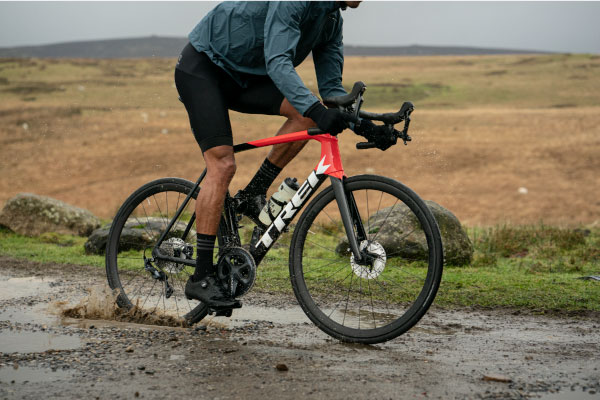
Choose by leg inseam
Some manufacturers provide bike sizing recommendations according to leg inseam.
People have different proportions and riding a frame size that matches leg length makes pedaling more efficient.
If you're new to road cycling, choosing a size based on your inseam a great place to start and you can use our road bike size chart above. If you want to learn more of the ins and outs of road bike fitting, keep reading.
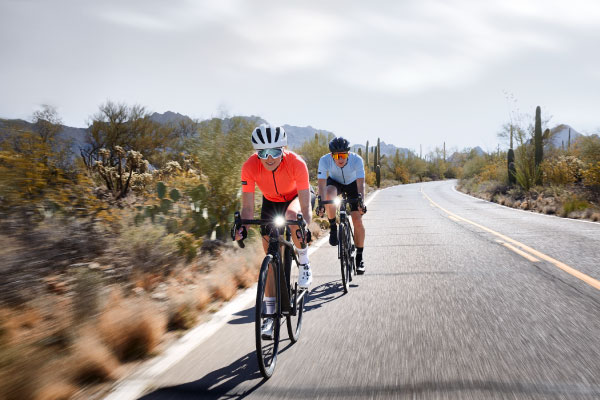
Choose by riding style and preference
If you're a seasoned rider or you want to do more research in order to get the perfect fit, you'll also want to consider your preferred riding style.
While the inseam measurement is still a great place to start, you can more easily decide between two sizes by looking at other bike-specific geometry measurements.
Based on how those measurements affect the bike, you can decide which of two sizes is better suited to how you ride.
How to measure yourself for a road bike
Measure your height by standing upright against a wall with your shoes off. Be sure to look straight ahead and keep your shoulders back. Mark the wall above your head with a pencil, holding the pencil flat and parallel to the floor. Then use a tape measure to calculate your height from the floor up to that mark.
To find your leg inseam, stand with your back against a wall and hold a book between your legs. The book’s spine should meet your crotch. If you’re alone, make a small mark where the spine hits the wall. Or a friend can measure from the top of the book down to the floor, in centimeters or inches.
Leg inseam is an accurate representation of the distance from the saddle down to the pedals and is important to get right for an efficient pedaling position.
How are road bikes measured?
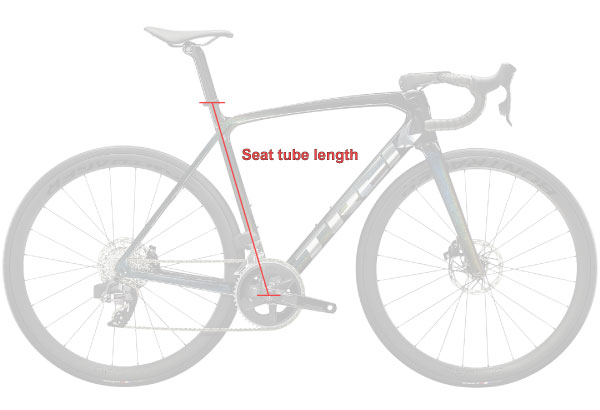
Seat tube length
Traditionally, road bikes were sized according to seat tube length, or the distance from the center of the bottom bracket up to the top of the seat tube. Frames were labeled with that measurement in centimeters rather than inches.
However, measuring the seat tube is no longer an accurate way to size a modern road bike. Nowadays, many bikes companies use approximations in order to keep their bike sizes aligned with the well-known CM sizes (like 54, 56, 58, etc) because modern geometry is a bit different. Some manufacturers also use alpha sizing (XS, S, M, L) to keep sizing consistent across models with different geometries.
So while seat tube is an important factor to consider, it is one of several key measurements that go into establishing a road bike frame as one size or another. Below are some of the other important measurements and how they affect frame size and general handling.
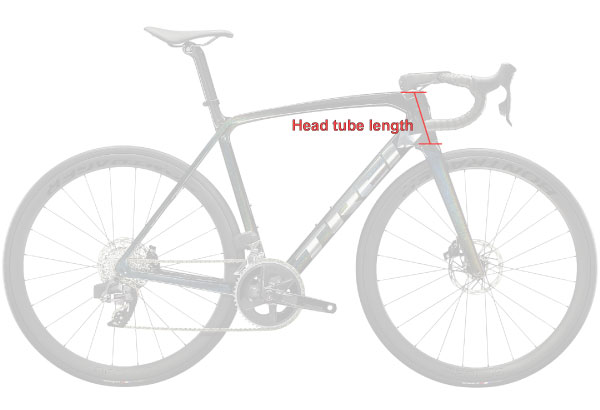
Headtube length
Headtube length is another factor to how far you need to bend over in the riding position. A taller headtube essentially raises the handlebars closer to your body.
While riders can use headset spacers to make small adjustments, it’s always better to use a frame that has a headtube length that matches your measurements. An appropriate headtube is much stiffer than the same effective length achieved using spacers at the top of the steerer tube.
Endurance bikes typically have longer head tubes than more aggressive race bikes.
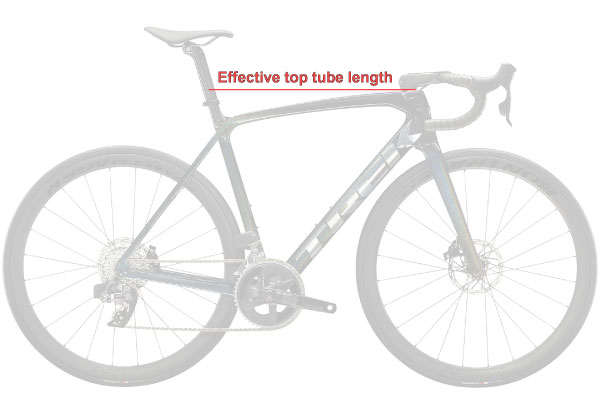
Effective top tube length
The modern sloped top tube design, measured using effective top tube length, affects the reach of a bike.
A longer top tube means there is more space between where you sit and where you place your hands which determines upper body posture.
Too long of a top tube and you will feel stretched out while a short top tube makes for a cramped feel.
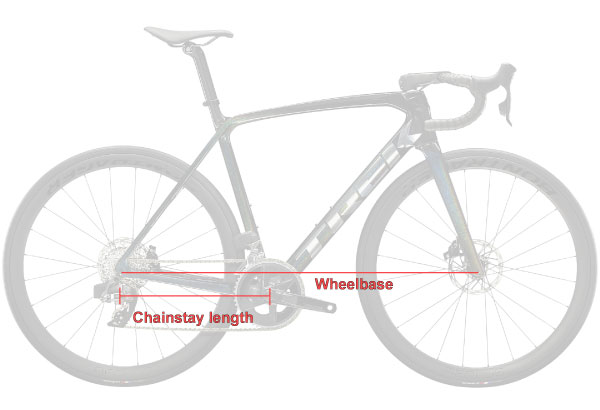
Chainstays and wheelbase
Chainstay length and wheelbase go hand in hand to determine a bike’s stability. Longer chainstays, measured from the bottom bracket to the rear axle, are a way to provide additional stability without affecting the rest of the frame too much, as well as providing wider tire clearance.
Longer chainstays extend the overall wheelbase. A longer wheelbase is more stable over rough terrain or at high speeds, but a shorter length provides a more agile and responsive ride. Long chainstays are a popular feature on endurance and gravel bikes where steady handling is desired.
How does road bike geometry affect sizing?
A bike’s geometry determines riding position as well as the bike’s handling.
Race geometry
Race geometry features a lower and longer riding position with a flat back and significant bend at the hips. This aerodynamic position has a lower center of gravity and offers more responsive handling, but can cause stress on the upper body over long distances.
Endurance geometry
Endurance geometry has a more upright position with relaxed measurements designed for comfort and stability rather than aerodynamics. Riders can enjoy extended training sessions with less strain on their back, neck, and arms.
Reach
Reach, or the horizontal distance between the bottom bracket and the top of the headtube, affects how far you lean over to grasp the handlebars. This can be altered by using a shorter or longer stem. Stack is the vertical distance from bottom bracket to top of head tube and is a good measure of how high the handlebars are relative to your upper body. Reach combines with the stack to determine bike fit.
A short reach and high stack make for a comfortable, upright enduro geometry. A long reach and low stack is an extended, aero riding position. This is why you might hear of pros ‘slamming their stem’ or removing all headset spacers to achieve the minimum stack height to force their bodies into a lower, more streamlined position.
Comfort is key
However aerodynamic a position is, if you are noticeably uncomfortable, that means you are probably inefficient, too. It’s important to find the right balance between comfort and efficiency for your body.
To figure out your ideal bike geometry numbers, receive a professional bit fitting at any of our three Alberta locations.
Let us help you find the right size road bike
Nothing beats getting on a bike and going for an in-person test ride. If you are unsure about your bike size or have questions about a specific model, come on in and chat with our bike experts.
Enjoy a test ride to feel the differences between distinct road bike geometries and discover what size road bike fits you. We offer precision bike fitting services to help you avoid injury or find additional performance gains.
Explore Our Top Road Bike Brands
Road bike size FAQs
What is the right size road bike for my height?
Check out our road bike size chart above to find the correct frame size for your height. You can double check the recommendation by measuring your leg inseam as well.
What size is a 54cm road bike?
A 54cm road bike is a medium sized frame appropriate for riders between 5’6" to 5'9".
What size is a 52cm road bike?
A 52cm road bike is a small sized frame ideal for riders between 5’3" to 5'6".
What size is a 58cm road bike?
A 54cm road bike is a large frame appropriate for riders between 5’9" to 6'0".
What frame size bike do I need road bike?
Road bike frames are sized according to rider height. Take an updated measurement of your height and check our road bike size chart above for a frame size recommendation.
I’m between sizes – which road bike size should I choose?
The general rule of thumb for road bikes is to size down if you are between frame sizes for road bikes. This avoids a stretched out riding position that can cause strain on the upper body.



